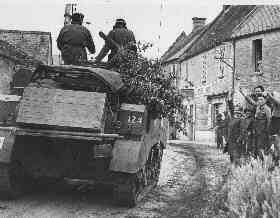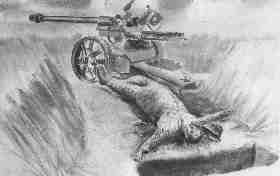 Other elements of the 8th Brigade pushed on towards their intermediate objectives inland. On the eastern flank, these included the high ground near the villages of Colomby-sur-Thaon, Anisy and Anguerny.
Other elements of the 8th Brigade pushed on towards their intermediate objectives inland. On the eastern flank, these included the high ground near the villages of Colomby-sur-Thaon, Anisy and Anguerny. By midday, the 7th and 8th Brigades had broken through the German beach defences and were pushing inland from Juno Beach. The reserve brigade, the 9th, had landed. There were, however, scattered pockets of resistance and one of the most troublesome was outside the town of Bernieres. Here a German strong point containing an 88-mm anti-tank gun blocked the exit. One platoon of Le Regiment de la Chaudiere managed to work its way 1500 yards inland to attack it and put it out of action.
By midday, the 7th and 8th Brigades had broken through the German beach defences and were pushing inland from Juno Beach. The reserve brigade, the 9th, had landed. There were, however, scattered pockets of resistance and one of the most troublesome was outside the town of Bernieres. Here a German strong point containing an 88-mm anti-tank gun blocked the exit. One platoon of Le Regiment de la Chaudiere managed to work its way 1500 yards inland to attack it and put it out of action.
Meanwhile, The North Shore Regiment fought steadily inland from the village of St. Aubin to Tailleville. Here they encountered the headquarters of the German 2nd Battalion, 736th Grenadier Regiment which was well dug-in, with numerous tunnels running from one gun pit to another, its weapons sited to cover all approaches. After some hard fighting, the North Shore men eliminated all resistance with help from two troops of Sherman tanks of The Fort Garry Horse.
 Other elements of the 8th Brigade pushed on towards their intermediate objectives inland. On the eastern flank, these included the high ground near the villages of Colomby-sur-Thaon, Anisy and Anguerny.
Other elements of the 8th Brigade pushed on towards their intermediate objectives inland. On the eastern flank, these included the high ground near the villages of Colomby-sur-Thaon, Anisy and Anguerny.
On the right flank of the beachhead, The Canadian Scottish reached their intermediate objective at about 1630 hours. Here they paused only briefly before pushing on deeper, suffering more casualties from enemy mortar and machine gun positions that had not been touched by the shore bombardment. By dusk, they were six miles inland from the sea. Canadian historian Reginald Roy has written that, of all the infantry battalions of the 2nd British Army landing, The Canadian Scottish in its final position had gone the farthest through the enemy defences. According to the Canadian military historian Colonel C.P. Stacey, the unit which probably got closest to the final inland objectives of all Allies assault forces that day was a troop of tanks of the 1st Hussars. This small unit raced ahead passed surprised German troops to reach the edge of Secqueville-en-Bassin, about a mile and a half ahead of The Canadian Scottish forward position.
At 2115 hours, Major General R.F.L. Keller, General Officer Commanding the 3rd Canadian Infantry Division, sent out his orders for the night. The brigades would hold the ground they had reached, carry out active patrolling, and be prepared to meet any German counter-attack in the morning. In the meantime, engineers continued their work on the beaches to clear the obstacles, sunken landing craft, minefields and debris. Constant boat traffic was going on, as supplies poured ashore to support the coming battles for the beachhead. In this narrow foothold that the Allies had secured on the coast, even the beach remained an area of danger from enemy snipers and air attacks.